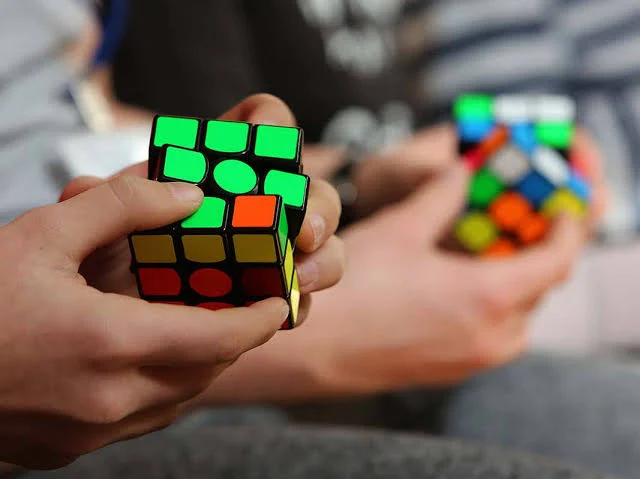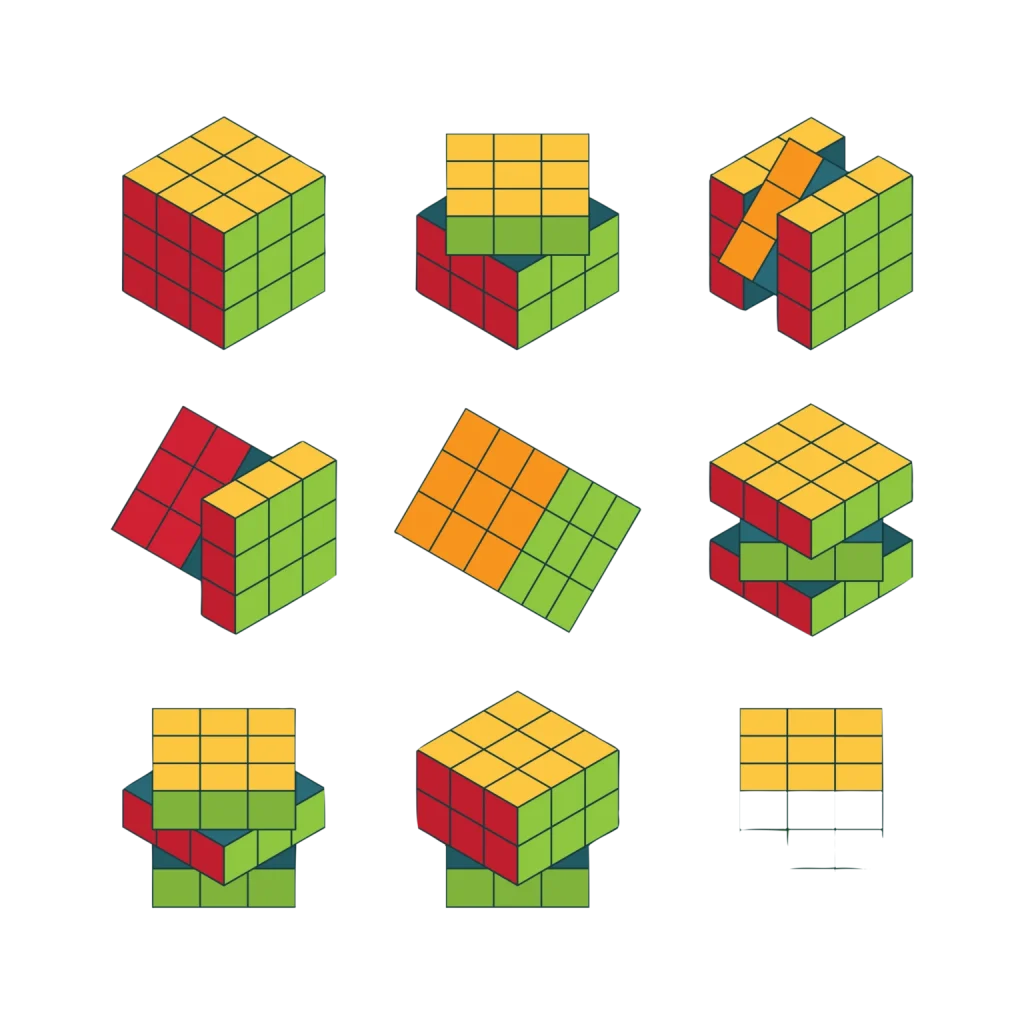It is commonly said that if you want to advance in something, you should begin at the very beginning. So, if you want to learn how to solve a Rubik’s Cube, keep reading till the conclusion. Let’s start with the fundamentals!
The Rubik’s Cube, developed by Erno Rubik, is a fascinating puzzle with 43 different quintillion configurations. A Rubik’s cube with dimensions of 3x3x3 is made up of 21 parts: one principle component with three axles, eight corner pieces (corner solid forms) with three tones, and twelve edge pieces with two tones.
However, it can be readily solved with the application of specific techniques. Nowadays, there are numerous varieties, but the most basic is the 3x3x3 Rubik’s cube.
- Why should you solve Rubik’s Cube?
- Basic Rubik’s Cube Structure
- Types of Rubik’s Cube
- Rubik’s Cube 3×3 Notations
- Building the White Cross on the Cube
- Arranging White Corner Pieces
- The Middle Layer of the Rubik’s Cube
- Building Yellow Cross
- Putting Yellow Cubes on Edges
- Positioning Yellow Corners where they belong
- Correct Orientation of Yellow Edges
- Some Tips
- Final Thoughts
- FAQ Section
Why should you solve Rubik’s Cube?

Now we’ll get to the meat of the matter: how can solving the Rubik’s cube make you smarter? Undoubtedly, solving it makes children smarter and improves their cognitive ability. Playing or solving the cube can enhance their capacity to operate under pressure. It aids in the development of problem-solving abilities in children. Moreover, it can also assist them in dealing with events calmly.
It takes a lot of dedication, determination, and effort to figure out the solution to the Cube, but it’s worth the work. Therefore, once they have learned it, and continue to practise the puzzle, their cognitive abilities will improve rapidly.
Basic Rubik’s Cube Structure

The basic Rubik’s cube (3×3) is made up of 26 small cubes. That means that the cube has 6 centrepieces, 8 corner pieces, and 12 edge pieces. The Rubik’s cube’s six faces are in six different colours: red, green, orange, blue, yellow, and white. Orange & Red, Yellow & White, and Green & Blue are the colours on the opposite faces of each other.
To solve a muddled cube, one needs to operate (rotating 90° clockwise or anti-clockwise) the faces either left or right to arrange the cubes of one single colour on one single face.
Types of Rubik’s Cube
The original Rubik’s Cube was released in 1980. Later this resulted in the development of hobbies and interests in puzzle design. Rubik’s cube is not only a difficult puzzle for most people, but it is also a meticulously constructed puzzle. By altering the parts, several individuals and businesses have built remarkable and harder alternatives to the original cube. Before we get into how to solve a Rubik’s Cube, let us go through some of the most well-known types of Rubik’s Cubes.
Cubes With Regular Shapes
Although the original Rubik’s cube has a 3x3x3 layout, the various sizes of the cube has influence on the layout. Among them are the following:
2×2
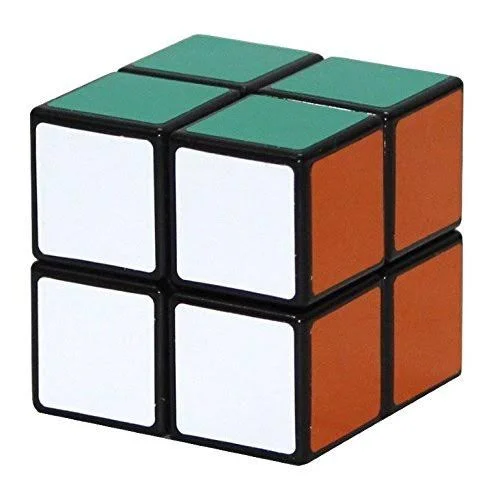
At first glance, this pocket cube appears to be a simple puzzle to solve, but it has over 3.6 million different combinations! Isn’t it confusing at times? The 2×2 Rubik’s Cube, often known as the Pocket Cube, is a two-layer Rubik’s cube.
“Mini Cube” is another name for it. However, in comparison to the Rubik’s Cube’s colour patterns, this cube only has four stickers on each face. As a result, the solution is to twist the cube and create your own path.
To purchase it, click here.
4×4
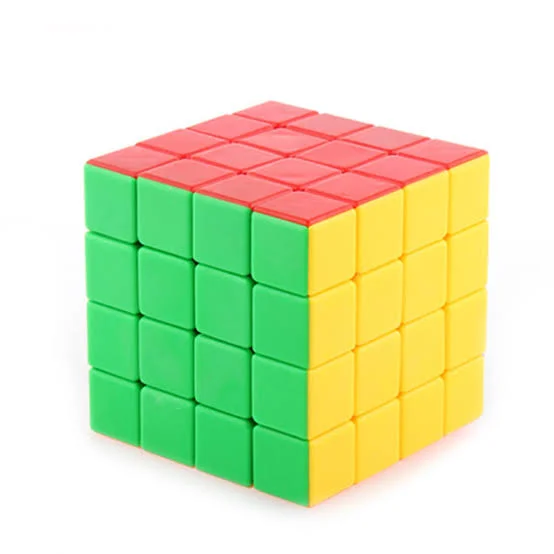
This type of Rubik’s Cube has twenty-four edges, twenty-four centres, and eight corners. It is a mechanism with algorithms and notations comparable to the Rubik’s Cube. However, the four centrepieces are bound together by a concealed centre.
Rubik’s Revenge is another name for the 4×4 Rubik’s Cube. It was first invented by Sebestény Péter, a Hungarian designer. There are numerous Rubik’s Revenge adaptations and variants based on the same mechanism and principle.
To purchase it, click here.
5×5
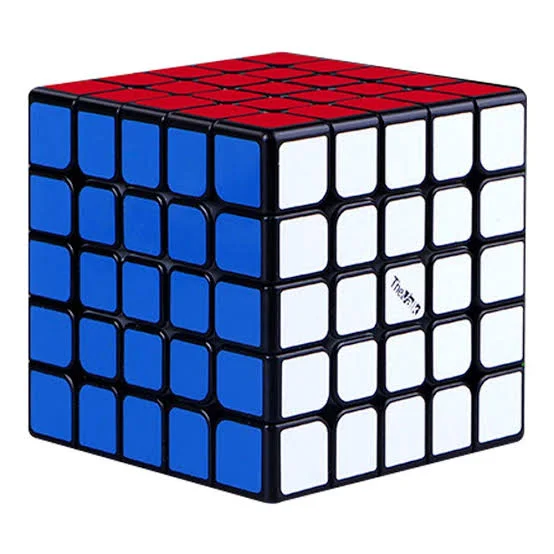
The approach to solving the 5×5 cube is similar to that of the original puzzle. It includes solving the centres, pairing the pieces to make the edges, and then solving it like a 3×3 cube. The Professor’s Cube is another name for the 5×5 Rubik’s Cube.
Udo Krell came up with the idea. This Rubik’s Cube has approximately 2.82 x 1074 potential combinations. This is equivalent to the number of atoms in the vastness of space.
To purchase it, click here.
6×6
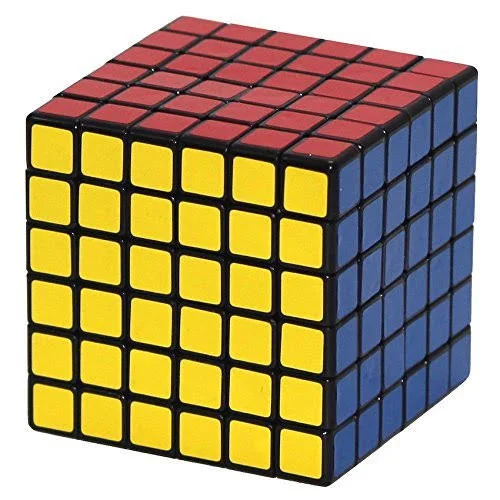
Unlike the other cubes, the 6×6 type has no set blocks. The centrepieces can be moved around easily. The only approach to tackle the 6×6 puzzle is to accurately determine all of the relative positions of the colours before applying 3×3 cube algorithms to the edges and corners. Panagiotis Verdes invented the 6×6 variant of the Rubik’s Cube.
7×7
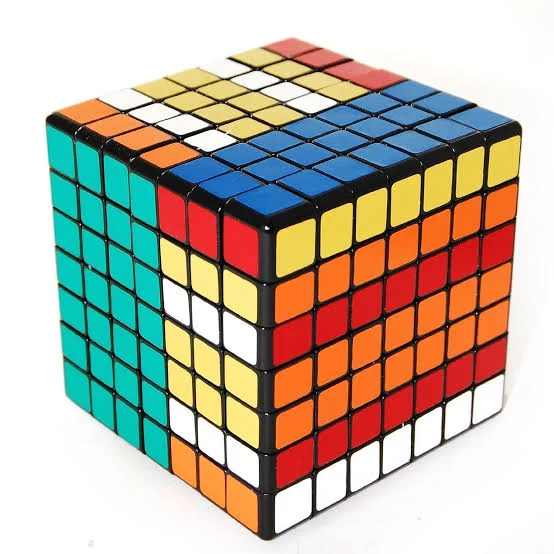
This cube is made up of 218 different smaller cubes. Out of which, six of them are linked to the internal frame and hence fixed in relation to one another. To solve this version of Rubik’s Cube, there are 1.95×10160 possible permutations.
Panagiotis Verdes, who also devised the 6×6 cube, created the 7×7 cube. This cube, like the 5×5, has both fixed and moveable centrepieces. The WCA (World Cube Association) hosts events ranging from 3×3 to 7×7 cubes. Apart from this, there are more sophisticated cubes ranging in size from 8×8 to 13×13 that are not part of the event.
Odd-Shaped Twisty Puzzles
The term “twisty puzzle” is given to the puzzles with unusual shapes that are inspired by the Rubik’s cube. Evidently, they are not cubes but rather other types of shapes. Like the Rubik’s Cube, to solve this type of puzzle these shapes need to be twisted and turned. For puzzle fans, there are a plethora of shapes, sizes, moves, and algorithms to choose from.
Some of them are the pyramid shaped puzzles called Pyramix. Another one is, the Skewb, which only turns at the corners. And lastly the Megaminx, which has dodecahedron like shape.
Pyramix
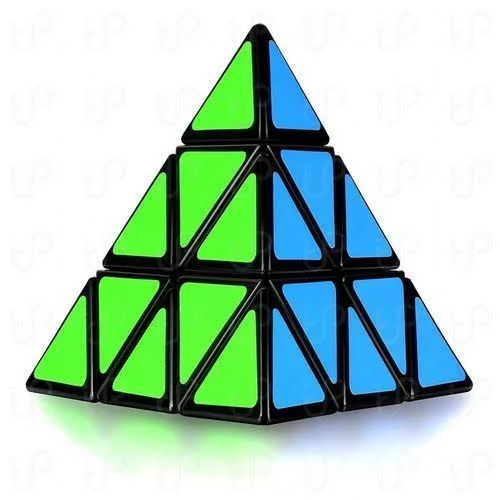
Uwe Méffert created this puzzle in 1971. Furthermore, the first official WCA Pyraminx tournament took place in year 2003. Andy Belleair was the winner who solved the problem in 14.09 seconds!
The Pyraminx is a tetragonal puzzle which has four triangular faces that are futher split into nine smaller identical triangles.
To purchase it, click here.
Megaminx
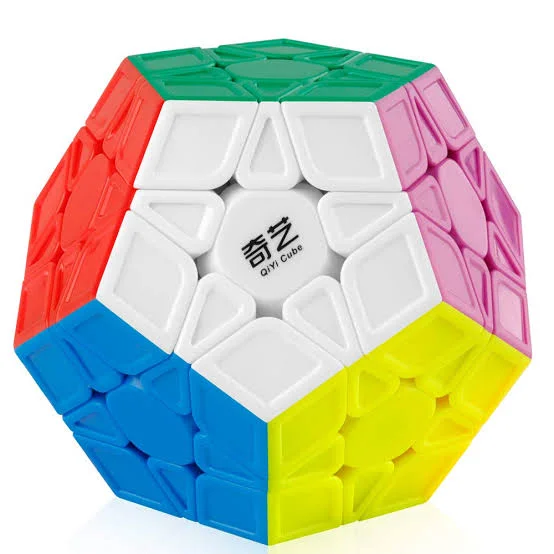
This is a dodecahedron-shaped cube with dynamics that are similar to the Rubik’s Cube class. With the addition of a few new algorithms, the answer to this puzzle is nearly the same. Initially it was known as the Hungarian Supernova which, later on, Uwe Méffert patented as the Megaminx.
Megaminx comes in a variety of shapes and sizes, but the most common has 12 colours and 11 pieces in a star design on each face. It has five corner pieces, five edge pieces, and a fixed centrepiece. There is a total of 50 componentsthat can be separated.
To purchase it, click here.
Skewb
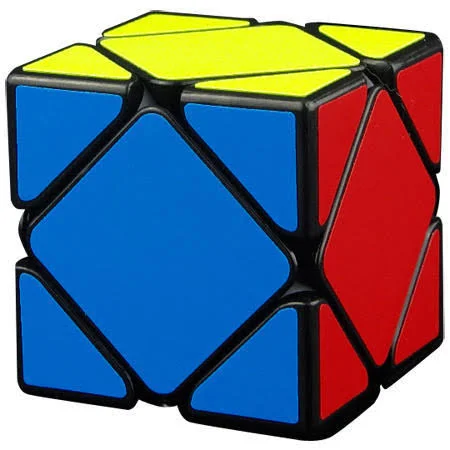
This puzzle can be considered a variant of the Pyraminx because it uses the same four-axis system. There are 8 corners and 6 square centrepieces in this puzzle. If you deconstruct this puzzle, you’ll notice that the cores are the same, and the four corners are the centres, while the other four pieces are the edges.
To purchase it, click here.
Square-1
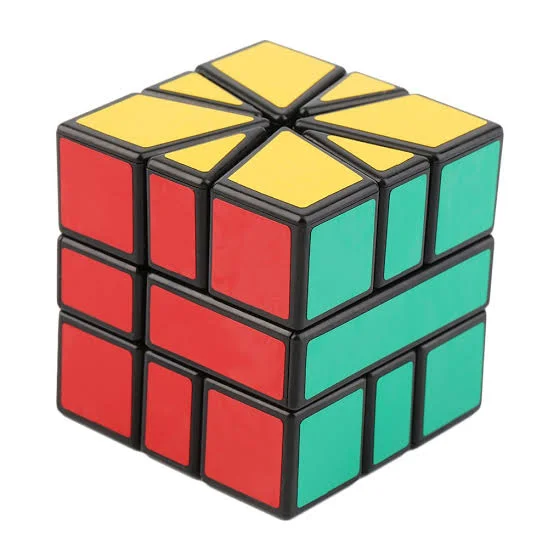
It’s a shape-shifting puzzle, and the solution is also one-of-a-kind. This is due to the fact that it features kite-shaped corners and triangular edges that blend in with the puzzle’s inner mechanism. As a result, the corners and edges can be swapped! It’s a WCA sanctioned competition, and Martin Edgal presently owns the record with a time of 4.59 seconds.
Cube 21 and Back to Square One were the previous names for Square-1.
To purchase it, click here.
Software-Based Cubes
On a computer or a smart device, players can solve cubes and other twisted puzzles using a variety of video games, online and mobile programmes, and even emulators. As a result, there are a bewildering variety of moves, twists, colours, sizes, and shapes in these puzzles, which are available as digital cubes and twisty puzzles.
Large cube simulators are available for cubes up to Size 100+. Due to pixel limits, these simulators are not compatible on all types of screens or monitors. Visual perception has its own set of restrictions. As a result, while endlessly huge cubes and other sophisticated twisty puzzles are theoretically possible, hardware and human limits make them unworkable.
Rubik’s Cube Benefits: 12 Amazing Physical And Mental Benefits of Solving A Rubik’s Cube
Rubik’s Cube 3×3 Notations
To solve the Rubik’s cube, one must first learn the notations. The first and most important step in solving a cube is to learn the notations. Just like alphabets are the essential building blocks for framing a language, notations function similarly in the context of a Rubik’s cube.
We use certain alphabets to define every rotation made on the cube. The letters used in cube notation are U, D, R, L, F, and B.
- Firstly, the letter U stands for clockwise rotation of the top face of the cube.
- Secondly, the letter D stands for clockwise rotation of the cube’s bottom face.
- Letter R stands for clockwise rotation of the right face of the cube.
- The letter L stands for clockwise rotation of the cube’s left face.
- Letter F stands for clockwise rotation of the front face of the cube.
- Similarly, B stands for clockwise rotating the back face of the cube.
Notions like “U”, “D,” “R,” “L,” “F,” and “B” stand for rotating their respective faces in the anti-clockwise direction (for example, “U” is used to rotate the top face of the cube in the anti-clockwise direction).
The digit 2, when used after an alphabet (for example, U2), means to clockwise rotate the upper face of the cube two times.
Now that we’ve talked about the cube notations, let’s start with how to start solving the cube.
Building the White Cross on the Cube
The first step in solving the Rubik’s cube is to construct the White Cross. This is probably the simplest and most instinctive step in solving the cube. Hold the cube with the white face on top (indicated by the fact that the core cube is white). Finally, arrange the white pieces together as shown in the picture below.

In the first figure, there are blue cubes on one face and yellow cubes on the other). Such a type of white cross is a good white cross. As in the second figure shown above, the faces adjacent to the white cross have cubes of different colours. This is what one should avoid.
Also read What is Speedcubing? How to Learn Speedcubing?
Arranging White Corner Pieces
The next step is to arrange the white corner pieces. When arranged correctly the left-out 4 corner pieces will complete one face of the cube. Hold the cube with the white cross on top.

With the corner pieces in the bottom as shown in the figure above, use the algorithm R’ D’ R D to fix the white corner.
With the corner piece on the top, use the algorithm R’ D’ R.
The Middle Layer of the Rubik’s Cube
The next step after solving the first layer of the cube is to solve the middle layer. To do so the left-right algorithms will be used to solve the layer.

If the cube looks like as shown above, we use the Left algorithm:
U’ L’ U L U F U’ F’

And if the cube looks like this as in the above figure, we use the Right algorithm:
U R U’ R’ U’ F’ U F

If the edge piece looks like as shown in the figure above, we have to use the algorithm twice.
Building Yellow Cross
Following the completion of the middle layer, the next task is to construct the yellow cross. The yellow face has to be on the top and then rotated until you see any of the patterns shown below.

In the 1st case, if you see a mirrored L on the top face of the cube, use the algorithm F U R U’ R’ F’
Coming to 2nd case, if you see a horizontal line of the yellow face of the cube, use the algorithm F R U R’ U’ F’
Finally, in the 3rd case, when yellow cube is in the centre of the face, use the algorithm F R U R’ U’ F’ U2 F U R U’ R’ F’.
Putting Yellow Cubes on Edges
Once the Yellow Cross is done, you have to make the yellow cubes on the edges face up in their final positions so that the colour of the side centre cubes matches. The Rubik’s Cube algorithm to use in this stage is as follows:
R U R’ U R U2 R’
We’re almost on the verge of solving our cube. Let’s quickly move on to our next step.
Positioning Yellow Corners where they belong
To solve this step follow the two types of algorithms of Rubik’s Cube
Algorithm 1: R’ F R’ B2 R F’ R’ B2 R2
Algorithm 2: F R U’ R’ U’ R U R’ F’ R U R’ U’ R’ F R F’
Place the yellow face of the cube on top. To swap the positions of C and D, use Algorithm 1. However, this only works if the two corners are aligned in relation to places A and B. If there are no corners that match, Algorithm 2 must be used to swap the positions of A and D.

Correct Orientation of Yellow Edges
This is the last stage in our cube’s solution. Though the corners have been placed in their final positions, they must be orientated as well.
The step requires two algorithms:
Algorithm 1: F2 U L R’ F2 L’ R U F2
Algorithm 2: F2 U’ L R’ F2 L’ R U’ F2
Here, to rotate EFG Clockwise use Algorithm 1 while to rotate EFG Anti-clockwise use Algorithm 2. If one of the corner edges are in correct position, use one of the algorithms listed above as needed. Use either of the above-mentioned algorithms if the corner edge isn’t placed correctly. This will bring the edge into position. Therefore, you can now further execute the required algorithm.

This is how you solve a Rubik’s cube!
Hence, if you are keen to learn more, this lesson talks about the mental and physical benefits of solving a Rubik’s cube.
Some Tips
- Firstly, the importance of mindset. Learning to solve the Rubik’s Cube is challenging, but perseverance is the key.
- To keep the same front face for an entire algorithm, keep the Rubik’s Cube on a table or use a mat.
- Consider the algorithms as if you were moving a piece out of the way, setting up its proper location, and then moving the piece back in.
- Before moving on to the next layer, master one layer by re-scrambling your Rubik’s Cube and practising several times.
- Furthermore, to help yourself remember the algorithms, consider learning it as songs and chants.
- Place a little sticky note on a Rubik’s Cube piece that you’re moving so you can track its progress.
- Also, make a video of yourself doing this and then watch it.
Final Thoughts
The Rubik’s Cube is an amazing puzzle that has enthralled generations of people. As you can see, there are numerous variations of the original Rubik’s Cube. Simple sticker cubes to complicated shape-changing cubes, there is plethora of choices. Thus, as designers build more difficult Rubik’s Cube varieties, you’ll have more opportunities to explore newer solutions and algorithms or potentially smash records!
After all, it is the job of parents to expose their children to such brainy challenges at a young age in order to upbring a smarter generation. When your child’s brain is still developing, give him or her a simple 3-D combination puzzle. Moreover, tackling the Rubik’s cube is a fun activity that helps your child’s brain develop in a variety of ways, effectively turning them into great minds.
Regardless of how much fun it is to solve a Rubik’s cube, the advantages are endless, and everyone should learn how to do so. Looking for a Rubik’s Cube class to encourage your child to learn this fascinating puzzle?
Do consider enrolling your child in Podium School’s Rubik’s classes to help them sparkle as they grow!
Stay updated on our blog for more news like this!
FAQ Section
How many types of Rubik’s cubes are there?
Rubik’s Cubes come in a variety of sizes and shapes, with the most popular being the 2×2×2 (Pocket/Mini Cube), normal 3×3×3 cube, 4×4×4 (Rubik’s Revenge/Master Cube), and 5×5×5 (Professor’s Cube).
What is the hardest Rubik’s Cube?
The Pentamix version of Ern Rubik’s Cube is the most difficult. It is definitely impressive. As a result, it is regarded as one of the most difficult Rubik’s cubes to solve.
What is a ghost cube?
In their most basic form, Ghost Cubes are puzzle modifications. They are one-of-a-kind puzzles with qualities that increase the difficulty of the cube they resemble — the solved state is obtained when the cube matches its description – a cube – rather than when all the colours match.
What is the easiest Cube to solve?
The nine-block Floppy Cube is one layer of a traditional Rubik’s Cube, making it ideal for a novice twister. Smooth movers can solve it in as few as eight clicks when it’s scrambled. Because there are only 192 possible colour combinations, even the most random guessers will get there eventually.
What does a Rubik’s Cube do to your brain?
According to Hobby Inspired, completing a Rubik’s Cube increases muscle memory. This is the area of the brain that recalls tasks after they have been performed several times. Typing, punching in PIN digits, playing the piano, martial arts, and even riding a bike are all activities that rely on muscle memory.
How do I choose the best Rubik’s cube?
Corner cutting, the speed of subsequent moves, and unexpected lock-ups are the three best features to seek in a 3×3 cube. Thus, these are the most important features to consider when purchasing a Rubik’s cube.

